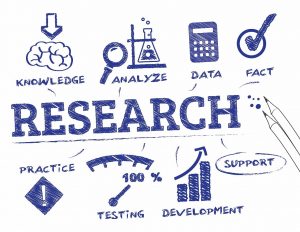
Research creates new knowledge
No greater thrill excites the super learner than discovering new knowledge. Research is the main way this is accomplished today. Knowing how to conduct research, how to locate and curate research material and how to distinguish fact from opinion are critical skills in the digital world we inhabit. The internet is a vast treasure trove of human experience, but it is filled with equal parts fiction and fact. Super learners know how to evaluate sources of information and how to create new knowledge through research.
In previous blogs, I have described how attitude, metacognition and memory play central roles in the learning process and how to maximize your learning by applying the best practices of super learners. With this two-part blog, I’ll first describe research methods and the role they play in knowledge creation. In the second part, I’ll delve into some of the most popular research methods in greater detail to give insight in how to maximize the potential of each one.
Research Methods Defined
Research methods are scientific procedures for collecting and interpreting information about a subject of interest. Since the 17th century, research has been based on the scientific method of studying a phenomenon, creating hypotheses to explain it and then testing those hypotheses through measurement and experimentation. The classical experimental research utilized in medicine and physical sciences relies on statistical and mathematical analysis to isolate root causes that explain why a phenomenon exists and operates the way it does.
Social and behavioral sciences have adapted the scientific method to their human subjects with some significant differences. First, most behavioral research is descriptive rather than experimental. We measure public opinion, economic activity, social and cultural trends and more, but we rarely subject these things to laboratory-controlled experiments. Indeed, ethical codes of conduct prohibit many experimental methods on human subjects. Second, behavioral research relies heavily on qualitative research methods such as interview, where the data is words filled with semantic meaning, not numbers. Qualitative data uses thematic analysis and interpretation to find patterns and extract conclusions. This provides great flexibility, but makes it difficult to generalize beyond the population under study. It also leads to differing conclusions and the emergence of competing interpretations that muddy the science and confuse the public.
In conducting research, we rely on both primary and secondary sources of information. Primary research is newly-collected information on a particular research question, while secondary research comes from the work of other researchers or experts who synthesize research for public consumption. A scientist testing a new chemical compound in a lab is conducting primary research. So is a pollster collecting survey data from consumers in a new opinion poll. Conducting a literature review on a topic is secondary research. In that case, we are relying on the work of others with no control over the data they collected or the way they analyzed it. This requires researchers to interpret the usefulness and relevance of this information to the subject of their research. Despite these drawbacks, we rely heavily on secondary research, since it is so much faster and easier to access and use. In doing so, we must carefully evaluate the quality of the source, since that will largely determine the value and accuracy of the research findings being presented.
Data Collection Methods
A number of data collection methods have been developed to support both quantitative and qualitative research. Five methods predominate:
1. Experiment – Conduct controlled scientific experiment to test cause and effect
2. Survey – Gather information from many subjects to understand characteristics of a population
3. Interview – Gather in-depth understanding from an individual subject
4. Focus Group – Gather in-depth understanding from a small group of subjects
5. Observation – Gather in-depth data about a subject in its natural setting
Since none of these methods answers all research questions and each has its limitations, researchers often combine two or more of these methods in a single research study so as to maximize the potential of discovering the truth. For example, behavioral scientists will often use interviews and focus groups to collect basic information about a topic and then use that to create a survey that collects more data from a larger population. By comparing results from these different data collection methods, researchers can triangulate findings that are supported by all methods and are likely to be closest to the truth.
Data Analysis Methods
Once data has been collected, it must be subject to analysis and interpretation for it to become useful new knowledge. Both qualitative and quantitative analysis methods exist to deal with a range of data. Qualitative analysis applies to data expressed as words or images. It is useful for interview, focus group and observation data. It is heavily dependent on the researcher’s judgement and subjectivity, so assumptions and biases are important to clarify. Quantitative analysis is appropriate when data can be represented numerically, such as survey ratings or precise measurements. In these cases, researchers apply statistics to examine trends, correlations and causal relationships. They use probability sampling methods to collect data and apply statistical confidence levels to their findings. This allows other researchers to replicate them based on standardized methods.
Four primary data analysis methods exist:
1. Statistical Analysis – Numerical data analyzed for descriptive and inferential purposes using mathematical modeling
2. Thematic Analysis – Qualitative data analyzed for themes and patterns of responses
3. Content Analysis – Analysis of large volumes of text or visual data to locate specific pieces of information
4. Meta Analysis – Analysis of large volumes of research studies to discover commonalities and differences
Research Reporting
Research is only useful if others have access to the knowledge it contains. For this reason, researchers are concerned about the reporting of their work. When reporting research results, it is important to be accurate, including the methods used and the limitations of the research and its findings. Primary research is often published in peer-reviewed professional journals subject to expert review to ensure it meets minimum standards for scientific research. This is one good way to validate the accuracy of primary research. Did it first appear in the New England Journal of Medicine or People Magazine?
Secondary research reporting is even more fraught with peril. It is easy to cherry pick a few research study findings to prove virtually anything. This makes the sources of secondary research critical, but even more so, the authors of the secondary research and what biases they may bring to bear on their subject. To be confident, trace secondary research back to the primary sources upon which it was built. For that reason, don’t ignore the footnotes which cite the sources of the findings being presented. Take the time to track down a couple of those sources and see how reliable and trustworthy they actually are. Secondary research conclusions based on shaky primary research amount to a house of cards that may collapse upon anyone who relies on them to make decisions. Super learners take the time to verify research sources and to understand the limitations of research findings. They also pursue primary research to add to the body of human knowledge. I will explore knowledge creation in more detail in part two of this blog on Research and Knowledge Creation.
